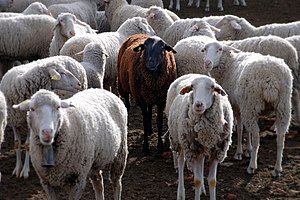Black sheep

In the English language, black sheep is an idiom that describes a member of a group who is different from the rest, especially a family member who does not fit in. The term stems from sheep whose fleece is colored black rather than the more common white; these sheep stand out in the flock and their wool is worth less as it will not dye.
The term has typically been given negative implications, implying waywardness.[1]
In
Origin
In most
Idiomatic usage
The term originated from the occasional black sheep which are born into a flock of white sheep. Black wool is considered commercially undesirable because it cannot be dyed.
The idiom is also found in other languages, e.g. German, Finnish, French, Italian, Serbo-Croatian, Bulgarian, Hebrew, Portuguese, Greek, Turkish, Hungarian, Dutch, Afrikaans, Swedish, Danish, Spanish, Catalan, Czech, Slovak, Romanian and Polish. During the Second Spanish Republic a weekly magazine named El Be Negre, meaning 'The Black Sheep', was published in Barcelona.[6]
The same concept is illustrated in some other languages by the phrase "white crow": for example, belaya vorona (бе́лая воро́на) in Russian and kalāg-e sefīd (کلاغ سفید) in Persian.
In psychology
In 1988, Marques, Yzerbyt and Leyens conducted an experiment where Belgian students rated the following groups according to trait-descriptors (e.g. sociable, polite, violent, cold): unlikeable Belgian students, unlikeable North African students, likeable Belgian students, and likeable North African students. The results indicated that favorability is considered highest for likeable ingroup members and lowest for unlikeable ingroup members, with the favorability of unlikeable and likeable outgroup members lying between the two ingroup members.
Explanations

A prominent explanation of the black sheep effect derives from the social identity approach (
Eidelman and Biernat wrote in 2003 that personal identities are also threatened through deviant ingroup members. They argue that devaluation of deviant members is an individual response of interpersonal differentiation.
Limitations
Even though there is wide support for the black sheep effect, the opposite pattern has been found, for example, that White participants judge unqualified Black targets more negatively than comparable White targets (e.g. Feldman, 1972;[15] Linville & Jones, 1980).[16] Consequently, there are several factors which influence the black sheep effect. For instance, the higher the identification with the ingroup, and the higher the entitativity of the ingroup, the more the black sheep effect emerges.[17][18] Even situational factors explaining the deviance have an influence whether the black sheep effect occurs.[19]
See also
- Black swan theory
- Dark horse
- Glossary of sheep husbandry
- Scapegoat
- Baa Baa Black Sheep
- The Ugly Duckling
- Low-life
References
- ^ ISBN 978-0-395-72774-4. Retrieved 2007-11-13.
- ^ .
- ISBN 978-0-670-17276-4.
- ^ The American Heritage Dictionary of Idioms. Houghton Mifflin Company. 1992. Archived from the original on 2008-04-15. Retrieved 2008-03-24.
- ^ "Red Sheep: How Jessica Mitford found her voice" by Thomas Mallon 16 Oct 2007 New Yorker Archived 6 June 2011 at the Wayback Machine.
- ^ El be negre (1931-1936) - La Ciberniz Archived 2013-02-11 at the Wayback Machine
- S2CID 144403591.
- S2CID 16867772.
- ^ .
- PMID 20565188.
- ^ Worchel, S.; Austin, W. G. (1979). The Social psychology of intergroup relations. Monterey, CA: Brooks-Cole.
- ^ Turner, J. C.; Hogg, M. A.; Oakes, P. J.; Reicher, S. D.; Wetherell, M. S. (1987). Rediscovering the Social group: A self-categorization theory. Oxford: Blackwell.
- ^ Hogg, M. A.; Tindale, S. (2001). Blackwell handbook of social psychology: group processes. Malden, Mass: Blackwell.
- .
- doi:10.1037/h0032313.
- .
- S2CID 2003883.
- S2CID 31260933.
- doi:10.5334/pb.942.
External links
- Exploration of the etymology of the phrase "black sheep of the family"
- Marques, José M.; José M. Marques; Vincent Y. Yzerbyt (1988). "The black sheep effect: Judgmental extremity towards ingroup members in inter-and intra-group situations". European Journal of Social Psychology. 18 (3): 287–292. . Retrieved 2008-01-04.
